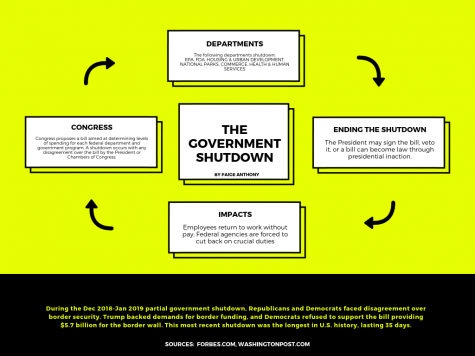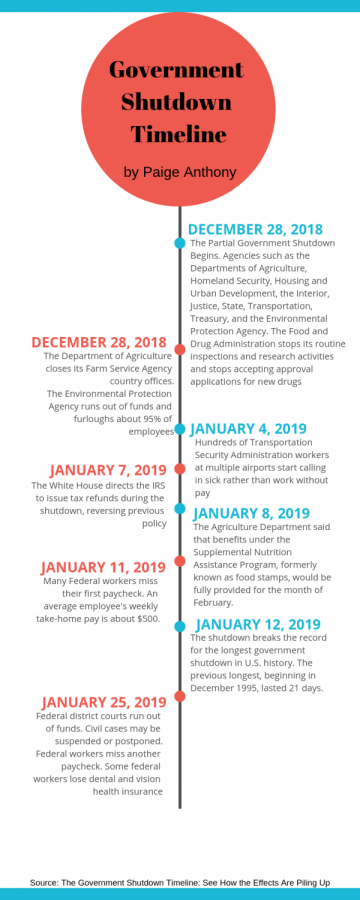Breakdown of the shutdown
US government furlough ripples throughout the nation
February 14, 2019
On Dec. 21, 2018, Congress let funding for roughly 25 percent of the federal government expire. By the midnight deadline, the House and the Senate had not passed a spending bill appropriating money to nine federal agencies, resulting in the shutdown.
This shutdown came to an end on Jan 25, 2019 after Trump signed a bill stating that he would end the partial shutdown for three weeks. This is all while negotiations over funding for the $5.7 billion border wall continue.
Pay has been restored for the 800,000 federal workers whom have been furloughed or forced to work without pay for 35 days.
In those 35 days, the FDA stopped its food inspections, Farm Agency offices closed, the Environmental Protection Agency ran out of funds for 95 percent of its employees, and airports experienced security delays.
If lawmakers and the White House fail to reach a budget agreement by Feb. 15, Trump warned of another shutdown. The President also stated that if he does not get a “fair deal” from Congress, that he may use emergency powers under the Constitution to address border security.
Without an approved spending plan, the government must shut down. Whenever the current spending bill expires, lawmakers must pass a new one to keep the government running. Usually they do, but occasionally they don’t, resulting in the shutdown.
In the about 40 past years, the government has shut down 20 times, according to Vox news.
The government reopens once Congress passes a spending bill to fund the government and Trump signs it into law.
“This was in no way a concession. It was taking care of millions of people who were getting badly hurt by the Shutdown with the understanding that in 21 days, if no deal is done, it’s off to the races!” Trump said in a Tweet on Jan. 25.
The country was seen approaching uncharted territory as the shutdown became the longest in U.S. government history. Trump quipped that the 2018 shutdown could have last months or even years.
With government workers living with no pay and shortages of air traffic control staff at airports, the struggles created by this record breaking shutdown began to show.
The 35 million children across the country who rely upon free or reduced cost school lunches do not have to worry if the shutdown were to continue.
In a January 9th advisory, the U.S. Department of Agriculture said it has enough previously approved funding to reimburse schools for meals provided through the National School Breakfast and Lunch Program through the end of February.
If the shutdown lasted longer than February, school districts would have needed to find emergency funds to cover the cost of food. The USDA was one of the nine federal agencies that remained shut down so long as President Trump and Congress did not reach a deal.
For now, the shutdown is over, but there may be lasting impacts on businesses and workers.
The U.S. could be in the same boat on Feb. 15.
Nebraska Governor Pete Rickett’s administration warned state agencies last December to brace for the impact of the partial government shutdown. In a memo sent to these agencies, he said not to assume that state money will be available to compensate them for lost federal dollars, and not to incur any new obligations that would require federal money that they have not yet received.
In addition to this, enforcement of fair housing, issuance of new development grants, and housing quality inspections will be delayed. Loans for new home buyers could also stall.
Funding for the Violence Against Women Act (VAWA) was also ceased with the shutdown. VAWA funds and administers numerous programs assisting survivors of domestic violence and sexual assault. Its expiration did not prevent any of the programs from being administered, but future payment requests would have experienced delay.
In Omaha, Offutt Air Force Base and the Army Corps of Engineers continued to function. On the other hand, at Eppley Airfield, about 200 TSA Agents would have worked over the Christmas of 2018, without knowing when they would receive their next paycheck.
Some federal employees needed to apply for unemployment benefits.
The Nebraska Department of Labor recorded 1,233 claims made on Dec. 22, and 2,211 claims made on Dec. 29.
“We’ve had 177 claims since the shutdown that are federally related,” said Commissioner of Labor John Albin.
Even if the shutdown continued, the Department of Labor and many other agencies would continue to receive funding until Sept. 30.
With the closing of the Department of Housing and Development, its enforcement of health and safety inspections of housing for low income families and elderly people with disabilities was suspended.
According to Monique Visoky, Social Worker at Omaha North High Magnet School, there is always the possibility that students that attend North may be directly impacted by the shutdown. This may affect students whose families work in jobs that have been affected by the shutdown and may currently be working without pay.
“Families that rely on assistance may be affected by delayed dispersion of benefits. Also, families that are attempting to apply for benefits or recertify for benefits may see a delay in getting approval and in that they would see a delay in receiving services,” Visoky said.
Should families need assistance in the meantime, they are welcome to reach out to Visoky for connection with services to help.



